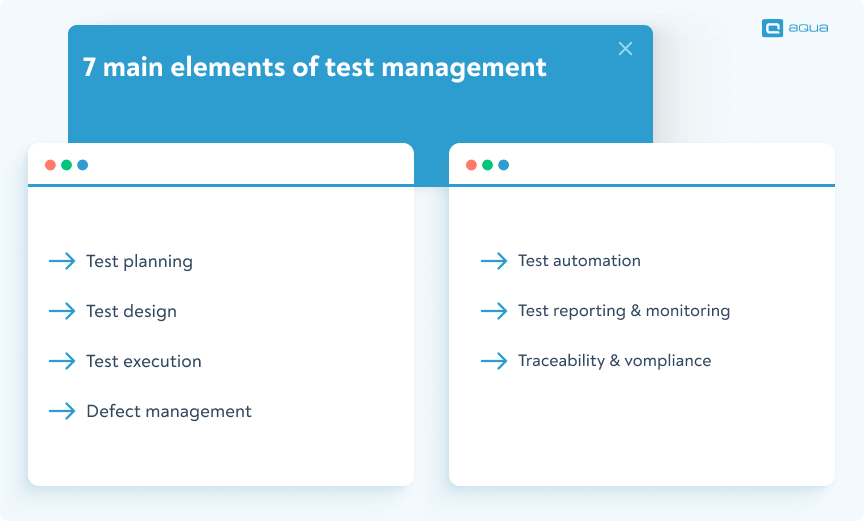Key Takeaways
- Test management tools centralize all testing activities, eliminating the scattered approach of spreadsheets that causes loss of time, money, and resources.
- Effective test management requires seven key elements: test planning, test design, test execution, defect management, test automation, reporting, and traceability.
- AI-powered test management solutions like aqua cloud can reduce test creation time by 98% through automated test case generation and reusable components.
- Most popular test management tools suffer from interface problems, slow performance, limited integrations, and poor customer support.
- When selecting a test management tool, focus on centralization capabilities, real-time insights, automation integration, AI features, and overall speed and stability.
Many teams are still drowning in spreadsheets and disconnected tools, unaware that modern test management solutions can eliminate 98% of their manual work. Find out how to choose the right tool that actually solves your testing challenges below 👇
What are the key elements of test management?
Choosing a test management tool requires a full understanding of test management first. You need to know what phases you have, so when evaluating a test management solution, you don’t go “Oh, this tool is really popular and cheap!” or “This one has got a 5.0 rating on Capterra, so it should be good!”
So here are the key elements (you can also see it as stages) of test management:
1. Test Planning
- Defines the testing scope, objectives, strategy, and required resources. Requirements are a big part of test planning.
- Includes test schedules, risk analysis, and entry/exit criteria.
2. Test Design
- This includes creating test cases, test scripts, and test data based on requirements.
- Your test coverage should align with functional and non-functional requirements.
3. Test Execution
- Running test cases, either manually or through automation.
- Logging defects and validating bug fixes.
4. Defect Management
- Identifying, tracking, prioritising, and resolving defects.
- Integration with tools like Jira or Bugzilla for efficient tracking.
5. Test Automation
- Automating repetitive and regression tests to increase efficiency.
- Compatibility with CI/CD pipelines for continuous testing.
6. Test Reporting & Monitoring
- Generating real-time reports on test progress, coverage, and defect trends.
- Providing insights into software quality and areas needing improvement.
7. Traceability & Compliance
- Linking test cases to requirements, defects, and user stories.
- Achieving adherence to industry standards and compliance regulations.

Real test management pain points come from having a chaotic understanding of the process. When you focus on single metrics instead of formulating a structured approach, you will:
- End up with a tool that does not fit your workflow
- Struggle with traceability
- Realise automation integration is a nightmare
- Spend more time managing tests than testing itself.
To avoid this, you also need to know how to pick your test management tool. More often than not, most teams just go with the most affordable or most popular solutions. However, as we mentioned, this often ends up in disaster.
How do I choose a test management tool?
Assuming you are either using Excel or a mediocre solution for your testing efforts, here is what you should look for when choosing a test management system (TMS):
1. Get centralisation so you are not drowning in spreadsheets and scattered tools.
If your test cases, defects and automation results are chaotically placed on Jira, Excel, or random reports, you need a solution that brings them into one place. You need to look for 100% centralisation – so every manual and automated test should be at a single repository.
2. You need to get real-time insights because reporting takes hours, sometimes days.
If you are still manually pulling test reports before every sprint review, your tool should provide instant dashboards. They should include test coverage, defect trends, and execution status.
3. Go for a solution that works with your stack because your automation integration could be a nightmare.
If your automation results don’t sync properly or require messy workarounds, you will spend more time on fixing the tool than on testing. Make sure the tool directly integrates with robust automation frameworks like Selenium, Cypress or Playwright.
4. Choose a solution that supports AI-powered augmentation so your testers do not spend a lot of valuable time on repetitive tasks.
If you spend hours rewriting test cases or running the same regression tests manually, you need generative AI. This AI should be able to generate test cases fast and suggest reusable steps.
5. Focus on speed and stability if your test management solution is slow and inefficient.
If every small action takes a lot of clicks and the UI confuses you, then it is time to move to something fast. A solution your testers won’t avoid and use comfortably, without any friction.
Hard to believe there is a solution that ticks all the boxes, right?
Wrong.
This is exactly why aqua cloud, an AI-powered test management system, exists – to take away the pain of testing.
With aqua, you eliminate the chaos. AI lets you create requirements, test cases, and test data within just three clicks, which is 98% more efficient than manual methods. The nested test cases feature allows you to reuse test cases whenever you need them. Want automation? Integrate any automation framework to aqua with native integrations (Ranorex, Selenium, Playwright, Cypress) or REST API and never worry about it again. With aqua, you get a centralised repository for both your manual and automated tests. With 100% traceability, every test, requirement and defect is linked in one place. Customisable reports with real-time insights mean you don’t need to be stuck pulling data before a sprint review. Ready to supercharge your testing efforts?
Get 100% efficiency with modern, AI-powered test management tool
Which tool is the best for test management?
Here is a long list of tools you can choose for test management:
1. aqua cloud – An AI-powered test management system that supercharges your requirements, test case, and test data creation by 98%. Automation integrations, customisable reports, bug tracking, centralised repository, 100% test coverage, traceability, and visibility. Full control of your testing process. Especially perfect fit for enterprises.
2. Zephyr – Jira plugin with test management capabilities that has huge interface challenges. It offers features for test case management, execution and reporting. However, the interface is overwhelming, there are slow load times and delays in executing tasks. Also, customer support delays responses, which disrupts the workflow.
"Sometimes clunky interface and changes not reflected. Addon goes to idle and requires a refresh every now and then."
3. TestLink – Open source test management with outdated infrastructure. For test case organisation and basic execution tracking, TestLink works well. But the interface is outdated, and the reporting features are basic and do not provide depth. Also, the number of native integrations is not high.
"One cannot use this software with multiple users for a long time like it really makes it difficult to use with so much data in it."
4. Practitest – End-to-end test management with cost and performance concerns. Test case creation and execution tracking are the solution’s stronger sides, meanwhile, high pricing, customisation options, and slow loading times will harm your experience massively.
5. Xray – Jira-native testing with storage limitations. It is deeply integrated with Jira, and almost does not exist outside of the Jira ecosystem. Apart from being super-reliant on Jira, Xray also creates a steep learning curve for the users unfamiliar with it.
“My team is currently using Xray and the most frustrating part for me is that you can't use regular search queries to filter for tests using Xray's test repository folder structure.”
6. SpiraTest – Comprehensive QA with interface and usability issues. A mix of languages on the interface confuses users. Customisation of reports is limited, and also, the problem with session management, like keeping users “logged in” can cause potential data loss.
7. qTest – Enterprise test management with a lot of problems. It is automation-friendly and has centralised test management, but the benefits almost end there. The pricing is high, the reporting limited, and the interface outdated. Some reviews confirm how problematic using Tricentis qTest can become:
Customer support has been abysmal since Tricentis took over qTest.
A user should not have to write an email to support learning how to file a ticket on the support portal. The support portal could be MUCH more user-friendly.
Before we go on with our list, let’s try something fun. Below is a scenario where you want to carry out simple QA test management tasks, in case you are using an inferior tool. Click to see the consequences:
🔥 Tool Nightmare Simulator (Click to open)
Experience the daily frustrations of using inferior test management tools. Can you survive the chaos?
Try to complete these simple tasks:
Sometimes, the requirements between qTest and JIRA did not sync well. There were many times when the number of requirements in each software was not the same. Along with this, some of the qTest add-ons such as Insights, are very difficult to work with and not intuitive as normal data analysis tools.
8. TestRail – A popular test management solution that gave up serving its users after being popular. There are no sophisticated AI-powered features and no robust customer support; the solution is not native to Jira. Slow updates and server errors, slow response times from support, and a lot of usability issues. If you go with the hype, you pay literally and figuratively. The choice is yours:
We recently updated to Version 8 and it's just shocking rubbish compared to Version 7. The cloud version is fixed but we use self-hosted which they haven't updated with some of the major bug fixes. For example, we currently cannot copy and paste images which for storing test results is an epic pain.
TestRail is absolutely awful and you should not switch to it.
9. TestMonitor – User-friendly test management with collaboration limitations. It is a simple, intuitive test management software platform built for enterprise software, quality app development, and other essential testing needs. But the collaboration features, shortly put, suck.
It would be nice to be able to assign multiple individuals to the same test runs and cases in a way that doesn't require each individual to execute the test runs independently, but instead collaborate on the same test run.
As you see from the list above, other tools help you manage tests, but they bring a lot of flaws with them. Aqua cloud helps you master them. AI-powered test creation speeds up your workflow by 98%, 100% traceability ensures nothing slips through the cracks, and seamless automation integrations make execution effortless. Integrations with Jira and Azure DevOps maximise your efforts, while one-click bug-recording native integration Capture allows you to generate the most visual bug reports. If you want full control over quality, aqua cloud is the only choice.
Rise above the rest - rely on 100% AI-powered, modern test management solution that cares for your concerns
Conclusion
Time to get real—most test management tools are like that one coworker who almost gets the job done but leaves you cleaning up their mess. Messy interfaces, glacial support, and “integrations” that do not work. But testing doesn’t have to suck.
With aqua cloud, you’re not just picking a tool—you’re upgrading your entire QA game. AI that cuts test creation time by 98%? Check. Flawless traceability so nothing slips through? Check. Automation that actually works? Big check.
Stop burning your days out with spreadsheets, drowning in Jira chaos, or begging slow-loading UIs to cooperate. The future of test management isn’t about surviving—it’s about dominating.


















